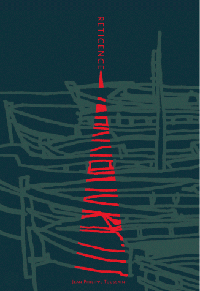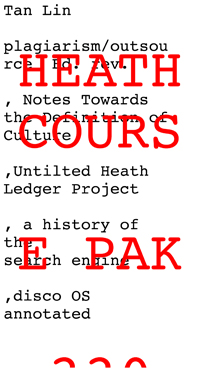RETICENCE
 RETICENCE
RETICENCE
by Jean-Philippe Toussaint
Dalkey Archive, Reprint 2012
104 pages / $12.95 Buy from Dalkey Archive or Amazon
Jean-Philippe Toussaint is a novelist who, in his initial success with publication, was often grouped alongside other novelists which many critics were considering the “post-nouveau roman writers,” writers who had, persumably, grown up reading the New Novel authors during their formative years while the New Novels were the pinnacle of literature in France. They were often marked by a return to a more, shall we say, straight-forward narrative, a return to character, but still displayed a marked attention to everything that the New Novel broke down.
It is, perhaps, not surprising then, that upon reading Toussaint’s short novel Reticence, I couldn’t help but think of Alain Robbe-Grillet’s seminal The Voyeur, published over 40 years before Toussaint’s novel (released in France in 1991, though just seeing English translation in 2012). While Toussaint’s novel avoids the fetishization & perversion that’s present “between the lines” of Robbe-Grillet’s novel (something that was seemingly never remarked upon by the author whom Barthes’ claimed wrote purely objectively), Toussaint’s novel also seems to be a detective novel which, similar to Robbe-Grillet’s novel, may or may not be missing the crime in its entirety, recalled only obliquely–recalled? or invented out of a reticence?
October 11th, 2012 / 12:00 pm
HEATH COURSE PAK by Tan Lin
 HEATH COURSE PAK
HEATH COURSE PAK
by Tan Lin
Counterpath Press, 2011
120 pages / $17.95 Buy from SPD or Amazon
In HEATH COURSE PAK Tan Lin continues his exploration of the ambient novel, focusing on the idea of how a book works and how a reader reacts to a book (literally a printed object) when its content bears no direct progression from A to B and instead offers tangential and obliquely-linked plagiarisms, outsourced ephemera, and meta-content.
Without a vague curiousity towards the book as an object, and how the book as an object works, there is little of interest here–this is a mass-produced artists’ book, battling with the world of conceptualism, occasionally tittering into poetry via the banality of its content (this is not surprisingly as Lin himself ‘began,’ shall we say, as a slightly-more straight-forward poet). It’s certainly interesting in theory, but in practice there’s no way to avoid the fact that reading the book, in the way one reads a traditional novel, is boring.
But, perhaps that’s a moot point. Lin’s intent seems to be related to, as he explains in an interview both in the book and in interviews various places over the internet, an interest in developing an ambient novel, in the way that Eno accidentally created an entire genre of music by releasing Music for Airports (though this in itself is also an arguable point, it draws an interesting point of comparison– Eno’s ambience still carried a significantly melodic mode, perhaps we could insist that ‘melody’ in music is ‘narrative’ in The Book–there is no melody in Tan Lin’s work, unless we stretch the metaphor to extend towards serial music, perhaps we can find something).
The book is interesting in that it’s specifically not interesting, it’s successful because of the way it fails, it succeeds so adequetely at what it sets out to do that as a book it becomes a mere chore, an exercise. But the stamina required is beautiful, and Lin’s trajectory through the world of literature, as an outlier questioning things completely different than anybody else, is entirely necessary.
October 9th, 2012 / 12:00 pm
Slime Dynamics
 Slime Dynamics
Slime Dynamics
by Ben Woodard
Zero Books, September 2012
84 pages / $14.95 Buy from Amazon
Ben Woodard’s SLIME DYNAMICS, recently released by Zero Books, offers a continuing exploration of subjects and modes of thinking developed over the last few years within the realm of philosophy that has donned the title of “speculative realism.” Woodard concerns himself primarily, both in this book and in his academic engagements, with the ideas of Dark Vitalism, which, as the book posits is
…the sickening realization of an inhospitable universe, stating that the production of life as an accidental event in time which is then contorted and bent by the banality of space, of our particular (and just as accidental) universal geometry and then further ravaged by accident, context, feedback and the degradation of wear and age.
Taking Dark Vitalism as its launching point Woodard continues to trace the idea of slime as “a viable physical and metaphysical object necessary to produce a eralist bio-philosophy void of anthrocentricity.” A turn away from anthromorphism, away from humanism perhaps, is another trade mark of developing thought, as it recenters the organicism of the world, the infinitude (outside of the phenomenological existence of human-beings–aka what came before Beings, what can come after, what this means). These continuing strands are carried throughout the short study in true continental style, vis a vis literary horror fiction, horror movies, video games and comics. This presents a fun context, at least for someone as genre obsessed as I am, to explore larger concepts.
While ultimately not utterly convincing in its case-studies, Woodard’s book does prove to be a fully engaging read and an interesting footnote on the development of speculative realism, specifically that of dark vitalism and the uncanny terror of the world carrying on without us.
October 4th, 2012 / 12:00 pm
